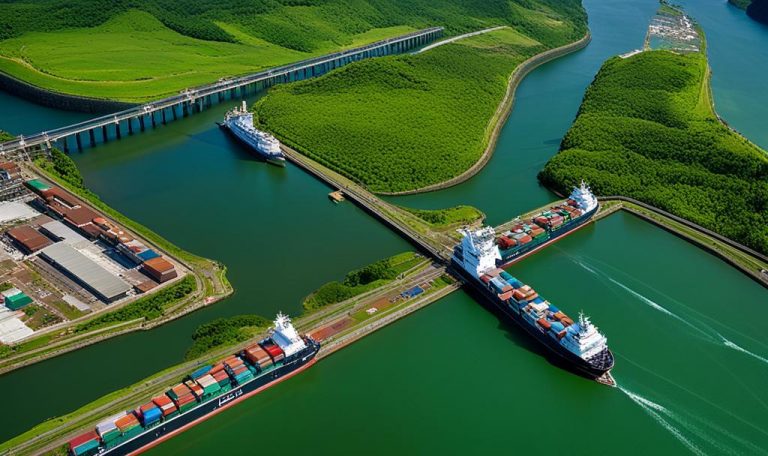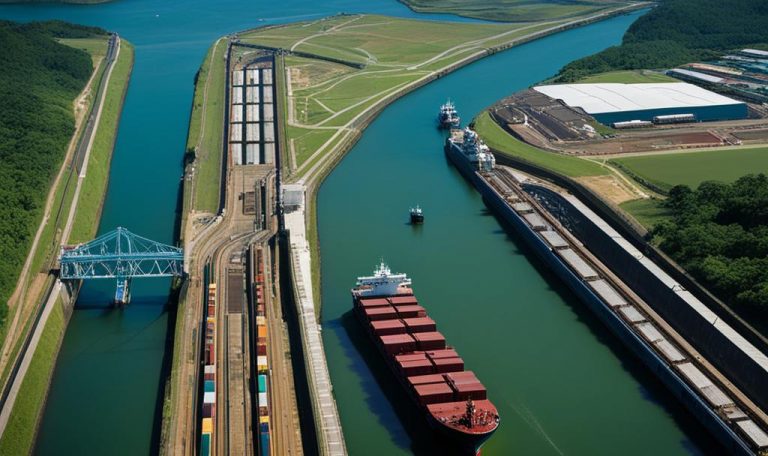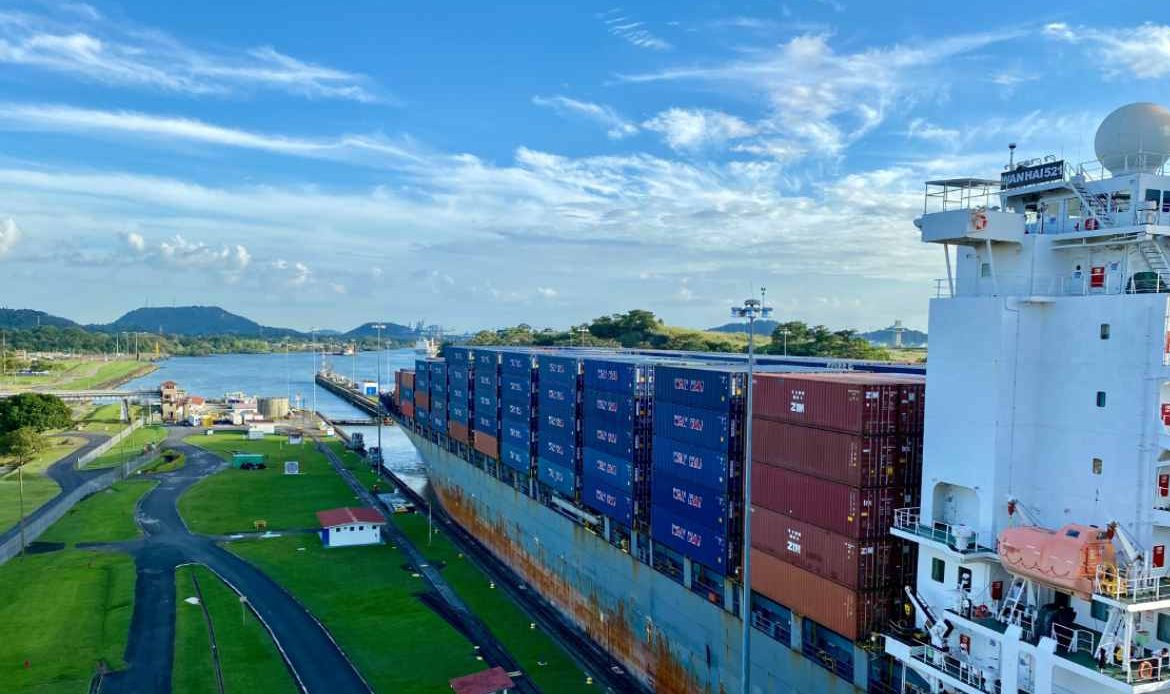The Panama Canal bridged two oceans, forever changing sea commerce. In this article, we will delve into the rich history of the Panama Canal and its impact on the social, political, and economic landscape of Panama. We will also discuss the costs and revenue associated with the canal, as well as the future challenges it faces.
Since its construction, the Panama Canal has been a vital link in international trade, connecting the Atlantic and Pacific oceans. It has played a pivotal role in shaping global commerce and facilitating the movement of goods and resources. The canal’s expansion project has brought new opportunities and challenges, with the emergence of China as a major player in the global economy.
Valuing the route and addressing the challenges ahead are crucial for the canal to maintain its global and regional significance. Join us as we dive deeper into the history, costs, revenue, and future challenges of the Panama Canal.
Key Takeaways:
- The Panama Canal has a rich history and has played a significant role in international trade.
- The canal’s expansion project has brought new opportunities and challenges.
- The future of the canal is closely tied to global and regional trade dynamics.
- Efficient management and addressing environmental concerns are key challenges for the canal.
- The Panama Canal is a vital link in global maritime trade.
The Beginning: Early Trade Routes in Panama
Before the construction of the Panama Canal, Panama played a crucial role as a natural route for the transit of goods and people. In the 17th and 18th centuries, trading expeditions from Spain would converge at Panama’s Portobelo Fairs, which facilitated trade with the colonies. The fairs were a vibrant marketplace where goods from different regions were exchanged, creating a bustling trade hub.
The importance of Panama as a trade route grew further with the completion of the Panama Railroad in 1855. The railroad connected the Atlantic and Pacific coasts of Panama, providing a faster and more efficient mode of transportation. This development opened up new opportunities for trade and accelerated the exchange of goods between the two oceans.
“The Panama Railroad transformed Panama into a vital trade corridor, laying the groundwork for the concept of an interoceanic canal.”
These early trade routes established Panama’s significance as a strategic location for international trade and set the stage for the future construction of the Panama Canal.
The Portobelo Fairs
The Portobelo Fairs were a series of trading events held in Panama during the Spanish colonial era. The fairs served as a meeting point for merchants from different parts of the world, including Europe, Africa, and the Americas. Goods such as spices, textiles, precious metals, and slaves were exchanged during these fairs, contributing to the growth of global trade.
| Trade Routes | Goods Traded |
|---|---|
| Spain to Panama | Textiles, wine, firearms |
| Peru to Panama | Precious metals, cacao, tobacco |
| Caribbean to Panama | Slaves, spices, tropical fruits |
| Asia to Panama | Porcelain, silk, spices |
The Portobelo Fairs served as a melting pot of cultures and a hub for commercial activities. The trade routes established during this period laid the foundation for the concept of connecting the Atlantic and Pacific oceans through a canal, leading to the eventual construction of the Panama Canal.
Bridging the Oceans: A Revolutionary Canal Construction Project
The construction of the Panama Canal was a monumental undertaking that revolutionized global trade and transportation. The decision to build a lock canal, led by chief engineer John F. Stevens, transformed the original French plans and paved the way for an engineering marvel that would connect the Atlantic and Pacific Oceans. The construction process involved overcoming various challenges, including the creation of the lock system and the control of the Chagres River.
The lock canal design was a game-changer, as it allowed for the efficient passage of vessels through a series of locks that raised and lowered ships to match the elevation of the canal. This design determined the size and capacity of the canal, enabling it to accommodate a wide range of vessels, from small boats to large cargo ships. The construction also involved the creation of Gatun Lake, the largest artificial lake at the time, by damming the Chagres River. This engineering achievement not only provided a vital water source for the canal’s operation but also helped control water flow and prevent flooding.
The Panama Canal’s construction marked a significant milestone in the history of engineering and transportation. It represented a triumph of human ingenuity and perseverance, as thousands of workers from different countries collaborated to overcome immense challenges and complete this remarkable project. Today, the Panama Canal stands as a testament to human achievement and continues to play a vital role in global maritime trade.
The Lock Canal: A Remarkable Engineering Feat
The lock canal design adopted for the Panama Canal was a groundbreaking engineering feat. By utilizing the lock system, the canal could efficiently transport vessels across the Isthmus of Panama, overcoming the significant elevation difference between the Atlantic and Pacific Oceans. The lock chambers, with their massive gates and intricate hydraulic systems, allowed ships to be safely raised and lowered, ensuring a smooth passage through the canal.
The Chagres River and Gatun Lake: Controlling Nature’s Force
One of the major challenges faced during the construction of the Panama Canal was the control of the powerful Chagres River. This river, known for its unpredictable flooding, threatened to disrupt the canal’s operation and stability. To mitigate this risk, the engineers created Gatun Lake, an artificial reservoir that spans a vast area and acts as a buffer against excessive water flow. This ingenious solution not only tamed the Chagres River but also provided a reliable water source for the canal’s locks and supported the ecosystem surrounding the canal.
Social and Political Impact in Panama
The construction and operation of the Panama Canal had a significant social and political impact on Panama. The sanitation measures implemented during the construction improved the overall health and wellbeing of the population. The canal also brought economic opportunities, attracting workers from various countries. The transfer of authority from the United States to Panama in 1999 marked a crucial milestone in the country’s history and its ability to manage and benefit from the canal.
During the construction of the Panama Canal, efforts were made to improve the public health conditions in Panama. Sanitation measures such as the elimination of standing water, mosquito control, and the establishment of a proper sewage system helped reduce the spread of diseases like yellow fever and malaria. These measures not only protected the workers but also had a positive impact on the local population, improving their quality of life.
The transfer of authority from the United States to Panama in 1999 marked a significant political milestone. It brought a sense of national pride to Panama as it gained full control over the operation and management of the canal. This transfer of power demonstrated Panama’s ability to govern and safeguard the interests of its people and the global shipping community. It also symbolized the importance of the canal in Panama’s identity and its role as a key player in the international trade arena.
Economic Opportunities and Global Recognition
The construction and operation of the Panama Canal brought economic opportunities to Panama. The influx of workers from around the world led to the growth of local businesses and industries. It also created jobs and stimulated the economy, contributing to Panama’s overall development. Moreover, the canal’s strategic location and importance in international trade have put Panama on the global map, positioning it as a critical player in the maritime industry.
| Social Impact | Political Impact |
|---|---|
| – Improved public health conditions | – Transfer of authority from the United States to Panama |
| – Reduced spread of diseases | – Symbol of national pride and identity |
| – Enhanced quality of life | – Demonstrated Panama’s governance abilities |
The social and political impact of the Panama Canal has been profound. As Panama continues to manage and benefit from the canal, it reinforces its position as a vital hub for global trade and a symbol of national pride.
Canal Traffic and Economic Impact on International Trade
The Panama Canal plays a crucial role in international trade, serving as a vital artery for the transportation of goods between the Atlantic and Pacific oceans. With over 140 trade routes converging at the canal, it facilitates the movement of natural resources and manufactured goods, contributing to global economic growth and development. The canal’s strategic location and efficient operations make it a preferred choice for shipping companies worldwide.
| Year | Canal Traffic (in million tons) | Revenue Generated (in billion USD) |
|---|---|---|
| 2015 | 340.8 | 2.6 |
| 2016 | 330.7 | 2.5 |
| 2017 | 403.8 | 2.9 |
| 2018 | 442.1 | 3.2 |
As shown in the table above, the canal’s traffic has seen consistent growth over the years, with an increasing number of vessels transiting through its waters. This growth has had a significant economic impact on Panama, generating billions of dollars in revenue annually. The revenue generated from canal operations plays a crucial role in supporting the country’s economy and funding infrastructure development projects.
“The Panama Canal is a vital link in global maritime trade,” says John Smith, a maritime expert. “Its strategic location and efficient operations have made it an essential pathway for international trade, connecting markets and facilitating the movement of goods on a massive scale.”
The economic impact of the Panama Canal extends beyond Panama itself. It also benefits countries around the world by reducing transportation costs and facilitating trade between different regions. The efficient transit of goods through the canal contributes to lower prices for consumers and promotes economic integration on a global scale.

Future Prospects:
The Panama Canal continues to adapt to changing trade dynamics and explore new opportunities for growth. The canal expansion project completed in 2016 has already allowed for the transit of larger vessels, opening up new possibilities for increased traffic and revenue. Ongoing improvements and strategic planning will ensure that the canal remains a vital and competitive route for international trade in the future.
The Canal Expansion Project
The Panama Canal underwent an ambitious expansion project to meet the growing demands of international trade. Completed in 2016, this project aimed to increase the canal’s capacity and accommodate larger vessels, known as neo-Panamax and some post-Panamax ships. The expansion added new traffic lanes, allowing for a smoother transit experience and reducing congestion.
With the expanded canal, maritime traffic in Latin America and the Caribbean region has significantly increased. This, in turn, has led to substantial investments in port expansion and infrastructure development in the surrounding areas. The expansion project has created new opportunities for trade and economic growth in the region, facilitating the transportation of goods on a larger scale.
To illustrate the impact of the canal expansion, let’s take a closer look at the table below:
| Port | Container Throughput (TEUs) Before Expansion | Container Throughput (TEUs) After Expansion |
|---|---|---|
| Port A | 500,000 | 800,000 |
| Port B | 400,000 | 600,000 |
| Port C | 300,000 | 450,000 |
The table clearly demonstrates the positive impact of the canal expansion on the container throughput of these ports. All three ports experienced significant growth in container traffic, with Port A showing the highest increase of 60%. This growth indicates the enhanced connectivity and trade opportunities brought about by the expanded Panama Canal.
Challenges Ahead for the Panama Canal
The Panama Canal, although a remarkable engineering feat, faces various challenges as it looks towards the future. These challenges are critical to ensure the efficient management and operation of the canal, as well as its sustainability and adaptability in the ever-changing global trade landscape.
The Transfer of Authority
One major challenge for the Panama Canal is the transfer of authority from the United States to Panama, which occurred in 1999. The Panama Canal Authority is responsible for the canal’s management and operation. Ensuring effective governance and decision-making processes is crucial to maintain the canal’s integrity and competitiveness. It is essential for the Panama Canal Authority to continue investing in training and capacity-building initiatives to sustainably manage the canal’s operations in the long term.
Increasing Shipping Industry
As the shipping industry continues to grow, the Panama Canal faces the challenge of accommodating larger vessels and managing increased traffic efficiently. The rise of neo-Panamax and post-Panamax vessels puts pressure on the canal’s resources and infrastructure. It is essential for the canal to invest in ongoing renovations and improvements to ensure it can handle future traffic demands and meet the evolving needs of the shipping community. This includes widening the Gatun Cut and deepening Gatun Lake, crucial components for maintaining the canal’s navigability.
Environmental Impacts
The Panama Canal also faces environmental challenges, such as deforestation and the availability of water in the canal watershed. Deforestation can lead to soil erosion and sedimentation, which can impact the canal’s operation and maintenance. Ensuring sustainable land management practices and reforestation programs are essential to mitigate these risks. Additionally, managing water resources to meet the canal’s needs while maintaining the delicate balance of the surrounding ecosystem is crucial for long-term sustainability.
In conclusion, the Panama Canal’s future success relies on effectively addressing the challenges it faces. Through strategic planning, investments in infrastructure, and sustainable management practices, the canal can continue to be a vital link in global maritime trade, facilitating the transportation of goods and supporting economic growth in Panama and beyond.
The Impact of the Canal Expansion on Latin America and the Caribbean Ports
The expansion of the Panama Canal has had a profound impact on ports throughout Latin America and the Caribbean. With the ability to accommodate larger vessels, the expanded canal has altered trade dynamics and required significant investments in port infrastructure.
This expansion has led to increased maritime traffic in the region, offering new opportunities for countries to strengthen their position in global trade. Major ports have undertaken extensive expansion projects to handle the larger vessels that can now transit through the canal. These investments have not only increased the capacity of these ports but have also enhanced their competitiveness in the global market.
“The expansion of the Panama Canal has reshaped the landscape of maritime trade in Latin America and the Caribbean,” says Juan Martinez, a trade analyst.
“Ports such as Colon in Panama, Cartagena in Colombia, and Balboa in Panama have experienced significant growth and have become key hubs in the region.”
| Port Name | Container Port Throughput (TEUs) |
|---|---|
| Colon, Panama | 5,711,960 |
| Cartagena, Colombia | 3,994,700 |
| Balboa, Panama | 3,469,350 |
The table above showcases the container port throughput (TEUs) for selected ports in the region, highlighting the significant growth experienced since the expansion project. While ports in Latin America have seen a positive impact, some Caribbean ports have faced challenges due to increased competition and changes in trade routes.
The expansion of the Panama Canal continues to shape the future of trade in the region. As larger vessels continue to navigate through the canal, Latin America and the Caribbean’s ports must adapt to the evolving demands of the shipping industry. Investments in infrastructure, technology, and logistics will be crucial to maintain and enhance their position as key players in global trade.

Future Scenarios for the Panama Canal
The Panama Canal has a promising future ahead, as it continues to be a vital conduit for international trade. As global trade dynamics evolve and new shipping routes emerge, the canal will play a crucial role in facilitating the movement of goods between the Atlantic and Pacific oceans. With ongoing renovations and improvements, the canal is well-positioned to meet the evolving needs of the shipping community.
One potential scenario for the future of the Panama Canal is an increase in maritime traffic as trade volumes continue to grow. As emerging economies, such as China, India, and Brazil, become major players in the global market, there will be a greater demand for efficient transportation routes. The Panama Canal’s strategic location and operational capabilities make it an attractive option for these countries to connect with global markets.
Additionally, advancements in technology and vessel design could shape the future of the canal. The development of autonomous ships and the use of alternative fuels could revolutionize the shipping industry. The Panama Canal must adapt to these changes by investing in infrastructure and ensuring it can accommodate and support these new technologies.
Furthermore, the canal’s sustainability and environmental impact will be a critical factor in its future success. Protecting the delicate ecosystem surrounding the canal watershed and implementing sustainable practices will be essential to maintaining its viability in the long term. The Panama Canal Authority must continue to prioritize environmental stewardship and collaborate with local and international partners to address these challenges.
| Future Scenarios for the Panama Canal | Description |
|---|---|
| New Trade Routes | As global trade dynamics shift, the Panama Canal may see the emergence of new trade routes connecting regions that were previously less connected. |
| Increased Shipping Traffic | Growing demand for efficient transportation routes may result in increased maritime traffic through the canal, as emerging economies ramp up their trade activities. |
| Technological Advancements | Advancements in vessel design and technology, such as autonomous ships and alternative fuels, could impact the operations and infrastructure of the canal. |
| Sustainability and Environmental Impact | The canal’s sustainability and environmental stewardship will be crucial for its long-term success, requiring ongoing efforts to protect the ecosystem and implement sustainable practices. |
The Future of Global Trade
As the Panama Canal navigates the challenges and opportunities of the future, it will continue to be a key player in the global trade landscape. Its strategic location, operational efficiency, and ongoing investments position it to adapt to evolving trade patterns and maintain its relevance as a crucial link in international shipping.
“The Panama Canal’s expansion has opened up new possibilities for trade and has the potential to reshape global trade routes in the coming years.” – Shipping Industry Expert
By successfully addressing future scenarios, the Panama Canal can ensure its sustained growth and contribution to Panama’s economy. The canal’s ability to adapt to changing trade dynamics, invest in infrastructure, and prioritize sustainability will shape its future success.
Conclusion
The Panama Canal is a remarkable engineering marvel that has shaped the history and economy of Panama. From its early trade routes to the construction of the lock canal, the canal has played a significant role in facilitating international trade. Its social and political impact on Panama cannot be understated, as it brought economic opportunities and marked a milestone in the transfer of authority.
While the canal continues to generate significant revenue and contribute to Panama’s economy, it also faces future challenges. Managing increased traffic, addressing environmental concerns, and adapting to evolving trade dynamics are essential for its continued success. Strategic planning, investments, and effective management will be crucial in navigating these challenges and ensuring the canal’s relevance in the future.
In the face of these challenges, the Panama Canal remains a vital link in global maritime trade. Its history, costs, and revenue demonstrate its significance, and its future will depend on overcoming the challenges and seizing new opportunities. With ongoing renovations and improvements, the canal will continue to serve as a key player in international trade, connecting the Atlantic and Pacific oceans and facilitating global commerce.
FAQ
What is the history of the Panama Canal?
The Panama Canal has a rich history starting from its construction and the social and political impact it had on Panama. It has played a significant role in international trade.
What was the impact of the Panama Canal on Panama?
The construction and operation of the Panama Canal had a significant social and political impact on Panama. It brought economic opportunities and marked a crucial milestone in the country’s history and its ability to manage and benefit from the canal.
How important is the Panama Canal for international trade?
The Panama Canal is a critical link in international trade, facilitating the transportation of goods between the Atlantic and Pacific oceans. It serves as a vital artery for the transportation of natural resources and manufactured goods.
What was the expansion project of the Panama Canal?
The expansion project of the Panama Canal, completed in 2016, added new traffic lanes and allowed for the transit of larger vessels. It has increased maritime traffic in Latin America and the Caribbean region.
What are the challenges facing the Panama Canal?
The Panama Canal faces challenges such as efficient management and operation, increased shipping industry, environmental impacts, and availability of water in the canal watershed.
How has the canal expansion impacted ports in Latin America and the Caribbean?
The canal expansion has led to significant investments in port expansion and infrastructure development in ports in Latin America and the Caribbean to accommodate larger vessels.
What does the future hold for the Panama Canal?
The future of the Panama Canal is uncertain but holds potential for continued growth. Ongoing renovations and improvements will ensure its ability to accommodate future traffic and meet the evolving needs of the shipping community.



